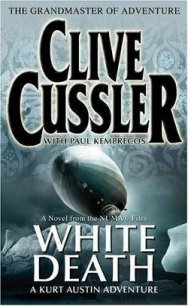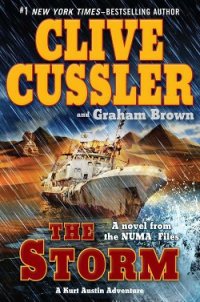The Navigator - Cussler Clive (читаем книги онлайн бесплатно полностью .TXT) 📗
The captain slapped Austin and Zavala on the back. “Grab your harpoons, boys. We’ve found Moby-Berg.” He gazed in rapture at the enormous berg. “Real pretty, eh?”
“Quite the little ice cube,” Austin said. “And we’re only seeing about an eighth of the berg above water.”
“There’s must be enough ice there for a billion margaritas,” Zavala said with undisguised awe.
Dawe said, “She’s a castle berg. Like the one that sunk the Titanic. The average berg in this neighborhood runs a couple of hundred thousand tons and maybe two hundred feet in length. This one is around three hundred feet plus and maybe five hundred thousand tons. The Titanic iceberg was only around two hundred fifty thousand tons.”
The captain ordered the helmsman to circle the berg, coming no closer than one hundred feet. “We’ve got to be extra careful,” he explained.
“Those projections poking from the water look as if they could scrape the barnacles off our hull,” Austin said.
The captain kept a level gaze on the berg. “It’s the obstructions we can’t see that I worry about. Those blue cracks are weak spots. A gigantic piece of ice could break off at any time and the splash alone could sink us.” Dawe flashed a quick grin. “Still glad you hooked a ride with us?”
Nodding in agreement, Austin tried to absorb the deadly beauty of the majestic ice mountain.
Zavala had shed all his reservations about the trip and stared spellbound at the huge berg. “Fantastic!” he said.
“Glad to hear that, my friends, because his baby belongs to you. A NUMA ship helped me out of a jam some years ago. This is my way of paying you back. The ship’s owners say liability won’t be a problem as long as you sign on as temporary members of the crew, which you’ve already done. You showed yourself to be naturals rounding up bergy bits.”
Dawe had let his guests lend a hand lassoing the smaller bergs, loosely misnamed after the fast-food specialty. Their teamwork and the way they quickly picked up the technique had impressed him.
“Those bergy bits were the size of houses,” Austin said. “That thing out there is as big as the Watergate complex.”
“The principle’s the same. Spot ’em. Encircle ’em, rope ’em, and tow ’em. I’ll be watching over your shoulder in case you get into trouble. Get into your foul weather gear. Meet you on deck.”
Austin and Zavala grinned like kids getting their first two-wheeled bike. They thanked the captain and headed to their cabin. They pulled on extra layers of warm clothing and slipped into full suits of bright orange foul weather gear. By the time they stepped out onto the open, the wind had picked up. The patched surface of the sea was as rough as alligator skin.
The captain watched closely as the two men worked with the crew to shackle together twelve-hundred-foot-long sections of eight-inch-thick polypropylene towrope. The towrope was attached to a cylindrical bollard on the aft deck and was paid out through a wide opening in the stern rail. An orange buoy was attached to the free-floating end. Austin used a portable radio to contact the bridge to say all was ready.
The ship moved in a big circle, staying about two hundred feet away from the berg, stopping to allow the crew to shackle sections to the towline.
When the Eriksson came back to its starting point, a crewman grappled the buoy end floating in the water and hauled it on deck. Austin directed the seamen to attach a wire towline to keep the rope low in the water. The line might slip off the slippery surface of the berg otherwise. The captain inspected the setup.
“Good job,” Dawe said. “Now comes the fun part.”
He led Austin and Zavala back up to the bridge. About half a mile of open water separated the ship and the berg; Dawe considered this the minimum distance for safe towing.
“I’ll let you take over from here,” Austin said.
He knew that this was no place for an amateur. Towed bergs have been known to turn over, and there was always the danger of the towline being tangled in the propellers.
Under the captain’s direction, the ship increased power. The towline went taut. The water behind the boat boiled in a white, foamy patch. The berg reluctantly overcame the inertia holding it in place. The huge ice mountain became unstuck from the sea, and they began to make slow headway. It might take hours to reach a speed of a single knot.
With the iceberg under tow, Austin excused himself and came back from his cabin a few minutes later. He presented a cardboard box to the captain. Dawe opened the box and his mouth widened in a grin. He lifted a broad-brimmed Stetson from the box and placed the cowboy hat on his head.
“A little large, but I can stuff newspaper inside to make it fit. Thanks, guys.”
“Consider it a small token of appreciation for having us on board,” Austin said.
Zavala was staring at the iceberg, which dwarfed the ship. “What are we going to do with that thing?”
“We’ll tow it to a current that will take it away from the oil rig. It could take a few days.”
“Captain—” The radarman called Dawe over to the radar monitor. “I’ve been tracking a target. Looks like it’s heading toward the Great Northern.”
The radar man had drawn three Xs with a grease pencil on a transparent plastic overlay and connected them to show the object’s course and time. The captain took a straightedge and lined it up with the markings.
“This isn’t good,” he murmured. “We’ve got a ship on a straight-line course for the oil rig. Moving fast, too.”
He radioed the Great Northern platform. The oil rig’s radar operator had spotted the oncoming ship and had tried to contact it. No one answered. He was about to call the Leif Eriksson when Dawe hailed him.
“We’re getting a little worried,” the radarman said. “She’s headed right down our throat.”
“That’s what it looks like,” Dawe said. “I figure she’s about ten miles out.”
“Too damn close.”
“We’ll dump the berg we’re towing and try to make an intercept. How long will it take to move the rig off the wellhead?”
“We’ve already started, but that ship could get here first if it stays at its present speed.”
“Keep trying to make radio contact. We’ll wave her off.” He turned to Austin and Zavala.
“Sorry, guys, but we’ll have to cut your berg loose.”
Austin had been listening to the radio exchange. He pulled on his foul weather top and clamped the cap down on his head. Zavala followed suit.
The release procedure was the reverse of the lassoing. The deck team detached the buoyed end of the rope to let it float free. Dawe maneuvered the ship back around the iceberg, and the crew reeled in the thousands of feet of line. When the last foot of line was on deck and pulled safely away from the propellers, the captain gave the order to move out at full speed.
Zavala stayed on deck wrapping up and Austin returned to the bridge. The microphone was clutched in the captain’s hand. “Still no luck?” Austin said.
Dawe shook his head. He looked worried, and he had clearly lost his patience. “We should be alongside those idiots before long.”
The captain went over to the radar screen. Another X had been drawn and connected to the previous course line. A second, intercepting course line had been drawn for the Eriksson.
“What are the chances the rig could sustain a direct hit?” Austin said.
“Not good. Great Northern is a semisubmersible rig. The legs offer some protection but nothing like the Hibernia platform, which is anchored in the bottom and protected by a thick concrete barrier.”
Austin was familiar with drilling platforms from his North Sea days. He knew that a semisubmersible rig is more of ship than a platform, used mostly for deep water. Four legs rest on pontoons that act as a hull. The platform is designed to be towed through the water, although some rigs can move on their own power. Once the rig is on a drilling site, the pontoons are flooded. Several massive anchors hold the rig in place.




